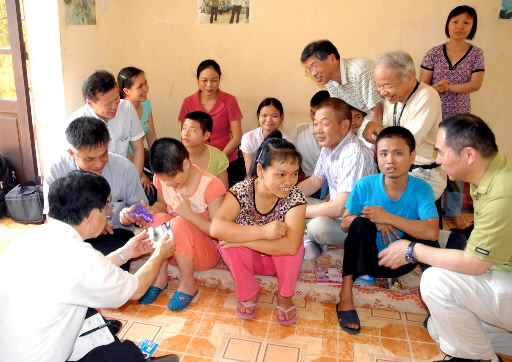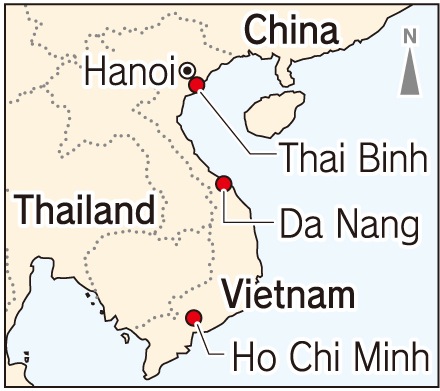Vietnam: 50 years after the use of defoliants, Part 1: Walking the affected areas, Article 6
Jul. 13, 2012
Article 6: Private support at a crossroads
37 years after the war’s end: How can efforts be carried on?
by Takamasa Kyoren, Staff Writer
Groups in Hiroshima and Yamaguchi: "Experiences must not be forgotten"
After the Vietnam War, government aid for local victims of defoliants was delayed. Humanitarian support from various private organizations around the world made up for this lack. Aid has come from Hiroshima as well.
In late April six men from the Hiroshima Vietnam Peace and Friendship Association, which is based in Higashi Hiroshima, visited a rehabilitation facility for disabled young people in Thai Binh Province, about 80 km southeast of Vietnam’s capital of Hanoi. The road to the facility passes fields of corn that were waving in the sultry air.
The facility houses 20 young people ranging in age from 14 to 24 who suffer from disabilities believed to be related to the effects of defoliants. As the men from the Hiroshima group, all in their 50s and 60s, entered a room filled with aging exercise equipment, they expressed their delight at being reunited with eight residents they had seen on a previous visit. “You’ve grown up,” said one in Hiroshima dialect.
Assistance with construction of facility
During the war, up to 450,000 soldiers were dispatched from Thai Binh to South Vietnam, the largest number of any province in North Vietnam. At 32,000, the province also has the largest number of victims of defoliants in Vietnam.
The rehabilitation facility was built in 2004 through the efforts of volunteers from Higashi Hiroshima and a Tokyo-based organization. Starting in 2001, they cooperated on charity concerts and raised money for the victims. The volunteers in Higashi Hiroshima formed the friendship association in 2009.
Since then they have donated notebooks and pens to the young people in the rehabilitation facility, and in order to support its operation they buy embroidery done by the residents when they visit Thai Binh.
“Suffering is continuing across generational lines here too,” said Goro Ono, 60, whose father was an atomic bomb survivor. Mr. Ono was making his first visit to the facility. He often worried that his children would suffer from the effects of radiation. Seeing the young people striving hard amid inadequate facilities, Mr. Ono renewed his determination to assist them.
“Thirty-seven years have passed since the end of the war. Fewer people from overseas come to visit,” said Nguyen Duc Hanh, 72, president of the Thai Binh Association for Victims of Agent Orange/Dioxin. “Our ties with Hiroshima are encouraging.” But most of the friendship association’s members are in their 50s, 60s or 70s. Tatsuo Akagi, 60, head of the delegation that visited in April, said, “It’s time to think about how our efforts can be carried on by the next generation.”
Resolve to continue efforts over the long term
The Hiroshima-Vietnam Association, based in Hiroshima City, which marked its 10th anniversary this year, has also been sending aid to victims of defoliants in Ho Chi Minh City. Tatsuya Hayashi, 72, the group’s president, was involved in an exhibition on the atomic bombing that was held at the War Remnants Museum in Ho Chi Minh City in 2002. “In both countries the number of those who lived through the war is declining,” he said. “I would like to continue to take action to ensure that their experiences are not forgotten.” In August four members of the group will travel to Vietnam and attend a ceremony marking the 10th anniversary of the founding of the Vietnam Association for Victims of Agent Orange/Dioxin (VAVA).
“What happens from now on may be the real support,” said Isao Iwamoto, 71, president of the International Medical Aid of Yamaguchi Association, which is based in the city of Kudamatsu, Yamaguchi Prefecture. No nationwide survey of the effects of defoliants has been made, and many people have yet to receive any aid.
Mr. Iwamoto formed the association in 1994 with doctors in Yamaguchi Prefecture. Since then they have invited doctors to come from Vietnam for training and donated medical equipment and wheelchairs. Along with his brother, Susumu, 69, who is a doctor, and others, Mr. Iwamoto conducted a survey on the effects of defoliants in Da Nang in central Vietnam from 1999 to 2001.
“In order to provide appropriate support you have to have a grasp of the extent of the effects,” Mr. Iwamoto said. “The atomic bombings, defoliants, the accident at the nuclear power plant – all of them will have long-lasting effects. I would like to keep providing support in Vietnam over the long term.” His resolve is firm.
(Originally published on June 24, 2012)









